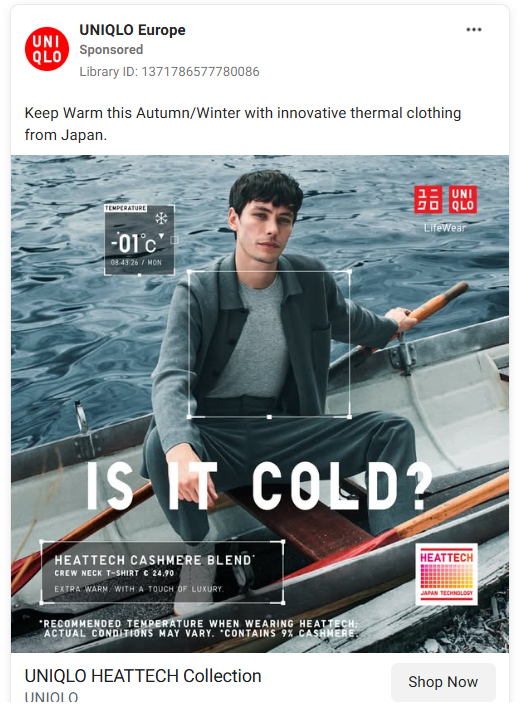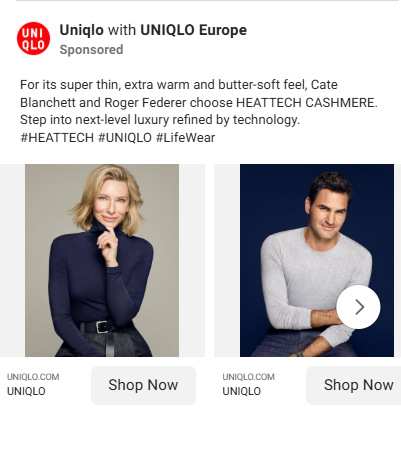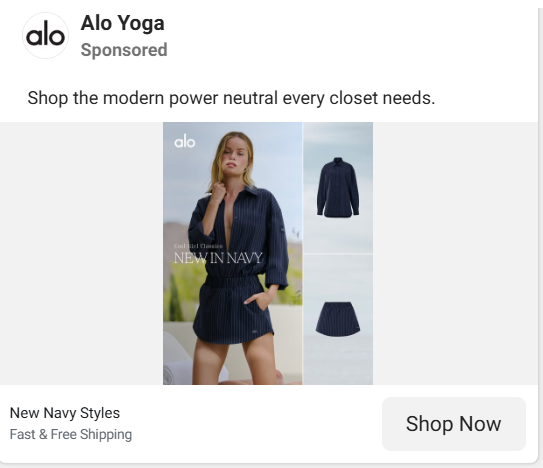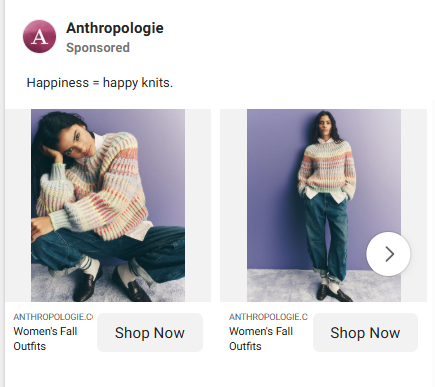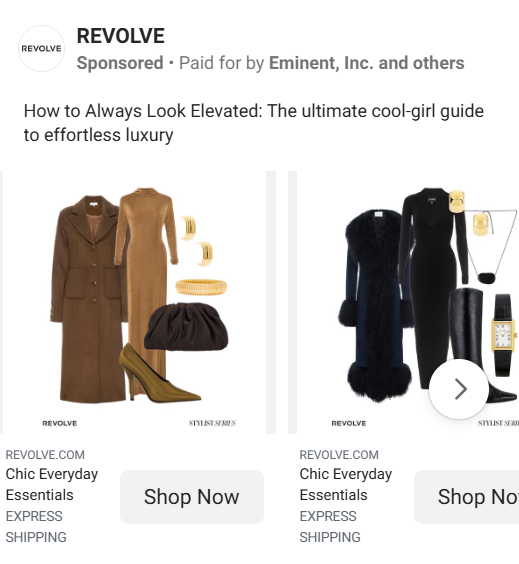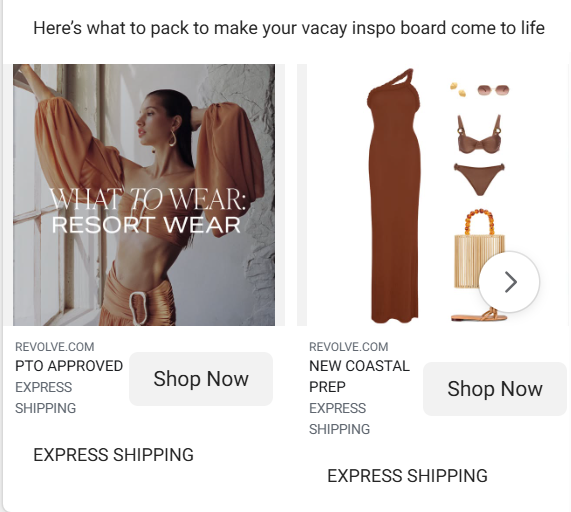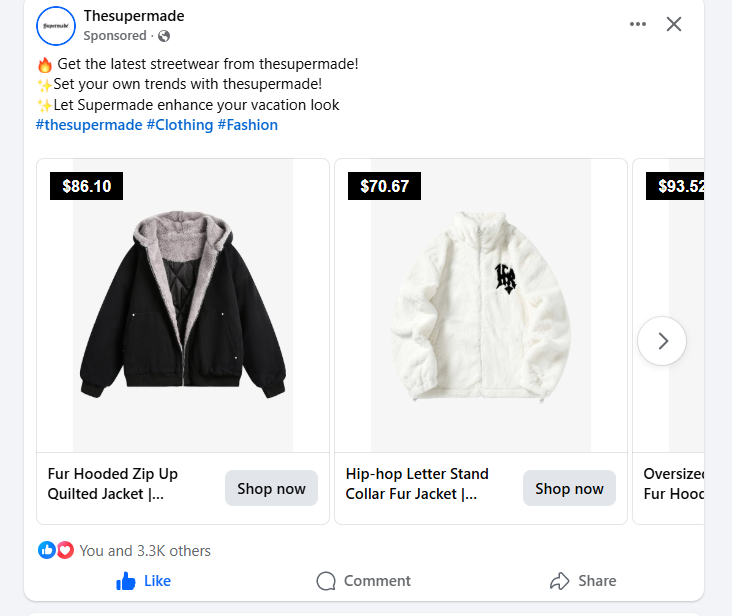9 High-Converting Clothing Store Ads and the Strategies Behind Them
Find out how Revolve, Uniqlo, and other top apparel brands convert customers with clothing ads. We examine 9 examples and show you how to apply the same strategies to your apparel store.


Worth $1.79 trillion in 2024, the apparel industry is one of the most lucrative spaces in eCommerce, which also makes it one of the most competitive. In fact, the average conversion rate for online clothing stores hovers around 2.2%.
It’s even harder if you’re a luxury brand since the conversion rate is just 0.7-0.8%.
Your clothing brand will no doubt require a great ad creative strategy to capture this market.
Today's article covers the nine most effective clothing store ads used by successful fashion brands. Each clothing ad idea is accompanied by real-world examples, so you can see exactly how leading brands apply them.
Key takeaways
- Knowing your target audience allows you to personalize ad creatives effectively, which is crucial since 71% of consumers expect tailored interactions.
- Competitive analysis helps uncover creative and messaging gaps that your clothing brand can capitalize on to stand out in a crowded market.
- Discounts remain one of the most powerful motivators for shoppers.
- Always-on catalog ads keep your brand visible between major campaigns while automatically updating to reflect your newest products.
3 things to do before you launch any clothing store ads
Fashion purchases are emotional. Shoppers usually aren’t comparing specs or features.
In most cases, they’re connecting with an image, a feeling, or a version of themselves they want to project via their fashion choices. Every successful clothing ad starts from that understanding.
With that in mind, here are the three foundations you need to cover before you start clothing advertising.
1. Get your branding right
Your brand is the foundation of every ad you create. So much so that 76% of consumers prefer to buy from brands they trust, even when cheaper options exist.
Branding statistics also indicate that 64% of shoppers stay loyal to a business because they share the brand’s values.
Your visual identity, colors, typography, and logo consistency, as well as your brand voice, must align with your target audience and what they care about. Whether you position yourself as a luxury brand, fast fashion, sustainable, or athleisure, your ads should instantly communicate that identity without explanation.
2. Define your target audience
Did you know that 71% of consumers expect brands to tailor their interactions, and 76% get frustrated when that doesn’t happen?
But how can you personalize your ads if you don't know who you're talking to?
Of course, if you're advertising on Meta, its AI can find people who might be interested in your products.
However, you must also do your own research to define your ideal customers because that information will influence your ad creatives and messaging.
When defining your target audience, don't just look at demographics. You should also have a good grasp of their values, lifestyle, aesthetic preferences, and shopping habits.
Your audience insights will also determine where you should focus your advertising efforts. For instance:
- Gen Z (13–25): TikTok, Instagram Reels, Snapchat
- Millennials (26–40): Instagram, Facebook, Pinterest
- Gen X and Boomers (40+): Facebook, Google Shopping
3. Perform a competitive analysis
Before you create your first ad, study what's already working in your space. Use the Facebook Ad Library to see exactly what ads your competitors are running in real-time.
You can also try these Facebook ad spy tools for more in-depth data on competitor performance and targeting strategy.
Pay attention to their creative formats. Are they using carousels, catalog ads, or videos?
What messaging are they leading with? What kind of offers are they promoting?
Just as important is spotting what they're not doing.
Look for gaps in their messaging, audiences they might be overlooking, or creative angles they haven't used yet. Those gaps are your opportunities.
9 examples of the best clothing store ads
Now that you've laid the groundwork, here are nine apparel ad strategies that are working right now.
1. Give the shopper an offer they wouldn’t want to miss
Discounts give shoppers a reason to buy now instead of later.
In fact, three out of four US shoppers prefer stores with discounts, and many spend more than they meant to once they see promotional deals.
Boohoo, one of the UK’s biggest fashion companies, uses this discount strategy regularly.
In this first example, Boohoo promotes an exclusive 10% off using a promo code. The discount offer sits right on top of the image, making it easy to spot.
The second ad takes a more aggressive approach with a 25% off everything offer.
The urgency is built into both the headline and the description, which specifies that this offer has an expiration date, so shoppers had better act fast.
The creative is also appealing because it uses bold typography and high contrast to make the 25% off impossible to miss.
In both of these examples, shoppers can see what they're buying and immediately understand the value they're getting.
2. Remind shoppers what makes your brand and product unique
If your competitors also invest in quality design and finishing, there's not much for shoppers to compare.
However, if you have something extra that sets you apart, that will tip the scales in your favor.
For Uniqlo, it's their HEATTECH thermal clothing from Japan.
The ad begins with a question that addresses the shopper's immediate need: cold weather. The copy then explains what makes the product special, which is the innovative thermal clothing to keep you warm in autumn and winter.
This Uniqlo ad is effective because it positions Uniqlo’s sweater as a product backed by innovation. That, and the descriptor ‘extra warm with a touch of luxury,' gives shoppers a reason to choose Uniqlo over any other brand selling warm clothing.
It's not just a plain sweater. It’s a sweater made with thermal technology and that makes it more attractive and ‘valuable’ than other alternatives.
3. Partner with influencers to reach a bigger audience
One of the most common apparel marketing tactics is to have influencers create organic posts featuring your product.
This, on its own, is effective.
In fact, according to influencer marketing stats, 70% of businesses earn $2 for every $1 spent on influencer partnerships.
However, if you want to reach more people, you can turn that organic influencer post into a paid ad.
Boohoo does this with influencer Phoebe Gore, who has over 400,000 followers on Instagram.
The above example shows what started as an organic post. Then, because it performed well organically, Boohoo turned it into a sponsored ad to reach more people across Meta's platforms.
Such influencer ads are effective because they don't feel like traditional ads. It's content people would engage with anyway, styled as a lifestyle moment rather than a product pitch.
In Bohoo’s example, the trench coat is featured, but it's woven into a story about travel and style.
Another option is to use celebrities to endorse your products.
The second example below shows Uniqlo partnering with Cate Blanchett, an Australian actor and film producer, and Roger Federer, a Swiss tennis legend.
The ad copy highlights the product's benefits while the celebrity endorsement adds credibility and aspirational appeal to the HEATTECH CASHMERE line.
4. Use seasonal themes to connect with shoppers
Black Friday, Christmas, Easter, etc, are all holidays that originated as ways to celebrate with family and friends, but they've evolved into major shopping events that customers eagerly anticipate throughout the year.
Apparel brands are perfectly positioned to take advantage of this.
If you saw this ad by Boohoo, you'd have no doubt about what season this ad is for.
The snowy setting, the winter coat, and the festive styling immediately tell you it's a Christmas ad.
If a shopper in a Christmas mood came across this, they’d definitely be tempted to click and see what they can get for themselves or their loved ones.
You can also do seasonal ads without tying them to a specific holiday.
This Revolve fall ad is a good example.
It is timely and relevant, which is why it can stand out in a crowded feed during the fall season.
The takeaway here is to match the mood of the season in your visuals and copy. It will help you connect more easily with shoppers who are already in a buying mindset.
5. Get customers excited about new arrivals
New arrivals naturally create a sense of urgency because shoppers want to be among the first to own the latest styles. Positioning products as fresh drops taps into that desire.
You can set this up easily through custom labels in your catalog ad tool. Tag items with labels like 'New Arrivals,' then run ads that highlight them.
You can use multiple image angles, like this example from Alo Yoga, to get shoppers interested in your product. That will give shoppers a sense of what the collection includes and how the items can be styled together.
Another approach is to display multiple new products in a catalog ad and place prominent text on your ads to draw shoppers' attention.
In Levi's example, they use a NEW ARRIVALS callout that's impossible to miss.
Both examples are effective because they suggest to shoppers that these are fresh products worth checking out.
6. Give shoppers multiple perspectives of your product
With apparel, one view is never enough.
Shoppers need to see how the product looks from multiple angles to feel confident about buying. They want to understand the fit, the finishing details, and how it might look on them.
You’ll see Anthropologie using this tactic a lot in their ads.
In the example above, Anthropologie shows two different styling options for their fall collection and that will allow shoppers to see the proportions and how the outfit comes together.
The second example shows a dress from both the front and back views. This is important for clothes, as shoppers want to know what the back looks like, especially for styles with unique details.
Consider what your customers care most about in your product and give them a visual that addresses it.
If it's the fit, show multiple body angles. If it's the fabric texture, include close-up shots. The more perspectives you provide, the easier it is for shoppers to picture themselves wearing it.
7. Tell stories to show the experience your product enables
A study tested how storytelling in radio ads affects emotions and sharing behavior. People who heard a story, especially one told by the brand's founder, felt more positive and were more likely to talk about the product.
That research confirms that storytelling creates more engagement than plain product descriptions.
Uniqlo knows about the power of stories, and you can see it in their ads.
In this example, they are advertising their winter clothing around an Iceland trip with creators from Europe and the USA.
Rather than listing product features, the ad focuses on the experience their HEATTECH Cashmere clothing affords users in extreme conditions.
This ad positions the clothing as gear that's been tested in actual conditions, not just modeled in a studio.
The storytelling, on the other hand, makes the product feel aspirational. Shoppers aren't just buying a warm sweater. They're also buying into the kind of experiences that this Uniqlo sweater can support.
8. Show shoppers how to style your products
One of the biggest barriers to online apparel purchases is uncertainty about styling and fit.
However, when you share curated fits, you remove that hesitation and make the buying decision easier.
Style-inspo type of ads work because they position your brand as a style authority.
We see Revolve take advantage of this strategy in the examples below.
In this first example, they create a guide around the popular cool girl aesthetic.
What makes this ad effective is that every outfit is fully styled down to the accessories. This removes guesswork and shows shoppers what items they need to achieve the aesthetic. Another plus is that this aesthetic is pretty popular and hence relatable to their target audience.
The second example takes a different angle by concentrating on vacation styling inspiration.
The ad combines a lifestyle image of resort wear with a flat lay of individual pieces styled together. That format will help shoppers understand both how the outfit looks when worn and what specific items they need to pack for their vacation.
This is one of the easiest ways to make your clothing store relatable to consumers.
Both examples work because they tap into trending aesthetics and true-to-life shopping moments.
You can apply this same strategy to other popular styles, such as the Clean Girl, Old Money, or Cottagecore aesthetics.
The only caveat when working with trends is to ensure the aesthetic aligns with your brand's positioning.
9. Use always-on catalog ads to keep your brand in view
These ads are useful for keeping your brand visible to potential customers even when you're not running any special campaigns.
Since these catalog ads are connected directly to your product catalog, they dynamically update as items come in and out of stock, prices change, or when you add new products.
Always-on ads are particularly effective for:
- Retargeting website visitors who didn't purchase
- Reaching warm audiences who've engaged with your content
- Maintaining brand awareness during non-peak periods
- Testing which apparel product sets generate the most interest
You can keep your always-on catalog ads as simple as the examples below.
However, based on our experience, it’s always better to enrich your catalog ads with interesting backgrounds, customer reviews, prices, and on-image text. You can learn more about how to do that on Cropink.com.
Final thoughts
Your apparel ads should connect with shoppers emotionally while providing a compelling reason to buy, whether that's through discounts, new arrivals, or engaging brand stories.
To get started, choose one or two strategies from this list that align with your brand and audience. Test them, track how they convert, and double down on the clothing store ad ideas that give you the best performance.
If you’re ready to create high-converting clothing store ads, check out our free fashion templates that come with a free Cropink account.
FAQs
You should use engaging visuals that show multiple angles, pair products with compelling offers or stories, and match your messaging to your brand positioning (luxury, affordable, sustainable, etc.).
One of the best ways to go viral is to partner with an influencer who matches your brand aesthetics. Another tactic is to lean into trending aesthetics your audience cares about, and use storytelling to stress experiences rather than just products.
You can use tools like Canva for basic ad creation, but if you need to produce hundreds of clothing store ads quickly and at scale, a specialized platform like Cropink is more efficient.
Sources
- Statista. Apparel market worldwide - statistics & facts
- 3DLOOK. The Average Conversion Rate for Fashion eCommerce
- McKinsey. Unlocking the next frontier of personalized marketing
- Capital One Shopping. Discount Marketing Statistics
- ResearchGate. The role of storytelling in advertising

Damaris is a Digital Marketing Specialist who writes about digital marketing and performance marketing. At Cropink, she creates data-driven content to help businesses run better ad campaigns for better performance and ROI.

Leszek is the Digital Growth Manager at Feedink & Cropink, specializing in organic growth for eCommerce and SaaS companies. His background includes roles at Poland's largest accommodation portal and FT1000 companies, with his work featured in Forbes, Inc., Business Insider, Fast Company, Entrepreneur, BBC, and TechRepublic.
Related Articles
Wondering what PMax campaigns are? Learn how Google’s fully automated ad campaigns use machine learning to boost conversions by up to 39% and lower CPA by 75%. See how PMax works across Search, Shopping, YouTube, and other major Google platforms in one campaign.

Without ad intelligence, every campaign you put out is a coin toss. Learn how ad intelligence works and why it’s a must-use for anyone who wants profitable advertising.

That product you looked at once is now everywhere you scroll. It's not a coincidence. This guide shows you how retargeting works, why businesses depend on it, and the steps you can take to stop ads from following you around.

Facebook raked in $164.5B in ad revenue in 2024—but are your ads pulling their weight? Discover the Facebook ad metrics that truly matter (CTR, CPC, ROAS) and learn how to optimize for real results, not just likes and shares.

Discover 16 of the best fashion ad examples from 2025, in a global market worth $1.84 trillion with over 2.8B users projected by 2029. Learn why these campaigns work — from cinematic minimalism to social-first UGC — and how to apply the same strategies to make your ads stand out.

Targeted ads double conversion rates by using AI, real-time tracking, and your data. See how it works—and how privacy laws are changing it.

Master the 12 essential digital ad types for 2025—learn which formats drive conversions, recover lost leads, and match your goals to your audience’s behavior. Avoid wasted budget and boost ROI with smart ad choices.

Are display ads still worth it in 2025? With Google Display reaching 90% of users and retargeting boosting conversions by 70%, the answer isn't so simple. Discover when display ads deliver real ROI—and when they don’t.

Brands love to get clever with their messaging, but sometimes, that cleverness crosses into manipulation. We break down 10 common advertising fallacies big brands use to sway you. You'll see real examples, learn why they work, and decide if you'd ever dare to use them yourself.

With 38% of Americans relying on social media for news, misleading advertising has never been riskier. Discover 7 real examples where small exaggerations led to lawsuits, brand damage, and lost trust—and why transparency is no longer optional.

Ad blockers usage statistics 2025 reveal key trends. Find out who’s blocking ads, their reasons, and how it impacts online advertising.

Instagram ad costs in 2025 range from $0.40–$1.73 per click—but with 2B users and 50% engaging daily, it's worth it if done right. Learn how to optimize your budget, boost engagement by 23% over Facebook, and avoid overspending.

How Can Cropink Help?
Start with Cropink is easy and free
No credit card required


